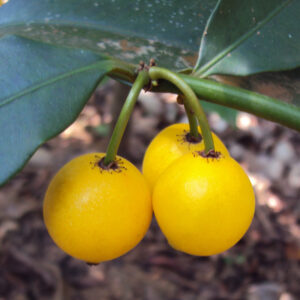Description
The ever-fruiting mulberry plant, scientifically known as Morus nigra (black mulberry) or Morus alba (white mulberry), is a wonderful fruit-bearing tree that produces delicious mulberries over an extended period. Here’s a detailed botanical description:
- Scientific Name: Morus nigra (black mulberry) / Morus alba (white mulberry)
- Family: Moraceae
- Origin: Native to regions of Asia, particularly China, but now grown in many parts of the world.
Appearance:
- Leaves: The leaves are deciduous, meaning they fall off in the autumn. They are simple, often heart-shaped with serrated edges, and can vary in size.
- Bark: The bark is usually grayish-brown with a rough texture.
Fruit:
- Description: Mulberries are small, juicy, and resemble elongated blackberries. They can be black, red, or white, depending on the species.
- Taste: The fruit is sweet and slightly tart, making it great for eating fresh or using in jams, pies, and desserts.
Cultivation:
- Light: Mulberry trees thrive in full sun, needing at least six hours of direct sunlight daily.
- Water: They prefer moderate watering, especially during dry periods. Well-established trees are quite drought-tolerant.
- Soil: They are adaptable to various soil types but prefer well-draining, fertile soil.
- Temperature: Mulberries grow best in temperate to warm climates. They can tolerate a range of temperatures but are best suited for areas that do not experience extreme cold.
Care:
- Fertilization: Fertilize in early spring with a balanced fertilizer to encourage healthy growth and fruit production.
- Pruning: Prune the tree in late winter to remove dead or crowded branches and to shape the tree. This helps improve air circulation and light penetration.
- Propagation: Mulberries can be propagated through seeds, but growing from cuttings or grafting is more common to ensure the desired fruit characteristics.
Benefits:
- Nutrition: Mulberries are rich in vitamins (especially vitamin C and K), minerals (such as iron and potassium), and antioxidants. They also provide dietary fiber.
- Longevity: The ever-fruiting varieties can produce multiple crops of fruit in a single growing season, providing a continuous supply of fresh mulberries.
The ever-fruiting mulberry plant is an excellent addition to any garden, offering not only shade and aesthetic value but also a bountiful harvest of nutritious fruit. It is relatively easy to care for and can provide years of enjoyment and sustenance.
4o






Reviews
There are no reviews yet.